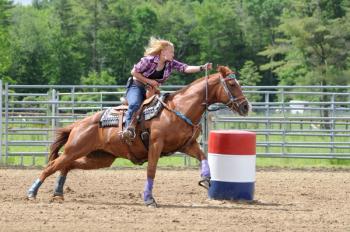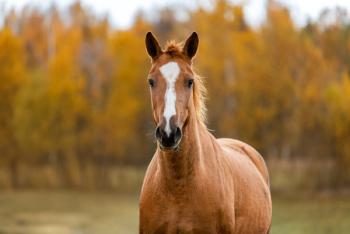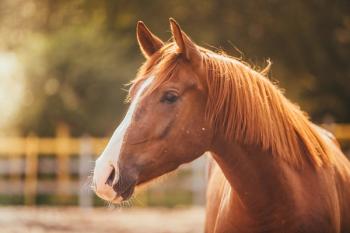
New 'toggle technique' helps horses breathe
What makes all the difference in this surgical procedure to treat recurrent laryngeal neuropathy? Two holes in the cartilage and a stainless-steel button.
The titanium suture button used to "toggle" the suture material (light blue) to the body and muscular process of the arytenoid cartilage (modified laryngoplasty technique). (Photos courtesy Santiago D. Gutierrez-Nibeyro)Morris Animal Foundation-funded researchers have developed a new surgical technique for recurrent laryngeal neuropathy (RLN) that is improving outcomes and helping horses breathe a little bit easier, according to a press release from the organization.
The technique, developed by researchers at the University of Illinois College of Veterinary Medicine, provides a stronger anchor point on the paralyzed cartilage within an afflicted horse's larynx to hold it open, and performs better than current surgical practices, says the release.
The research team published their findings in the
“We were really pleased with our results and feel this is the way we're going to be correcting RLN in the future,” said Santiago D. Gutierrez-Nibeyro, DVM, MS, DACVS, DACVSMR, clinical associate professor of equine surgery and the study's lead investigator, in the foundation release. “It's a biomechanically superior technique to treat a limiting condition in horses that are supposed to perform, possibly saving them from having to be euthanized or given away by their owners.”
The traditional suture placement through the muscular process.RLN is a degenerative disease in larger horses, explains the release, leading to progressive partial paralysis of the left half of the larynx. While not life-threatening in most cases, it greatly hinders a horse's ability to breathe during exercise. For working thoroughbreds or Clydesdales, this naturally constrains their performance. The cause of the condition is unknown.
The most popular method to treat RLN is a prosthetic laryngoplasty, also called tie-back surgery, according to researchers. Veterinarians restore normal airway function by placing prosthetic sutures in the cricoid and arytenoid cartilage, keeping half of the larynx in an open position. Unfortunately, cartilage tissue is soft and does not hold sutures well. The procedure often fails over time, if not immediately.
To improve on this, the research team developed what they call the "toggle technique" by working with horse cadavers. The team drilled tunnels in the cartilage, ran nonabsorbable suture material between the two points, and placed a stainless-steel button as an anchor at one end. This button provides a larger, more stable contact surface.
The team tested larynxes with the toggle technique against larynxes with tie-back surgery by mimicking the forces a horse would create while swallowing or coughing, according to the release. The toggle technique models had a significantly greater survival rate over 10,000 cycles. Dr. Gutierrez-Nibeyro said his team has tried this new technique on a handful of live horses as well with positive results.
See an abstract
Newsletter
From exam room tips to practice management insights, get trusted veterinary news delivered straight to your inbox—subscribe to dvm360.





